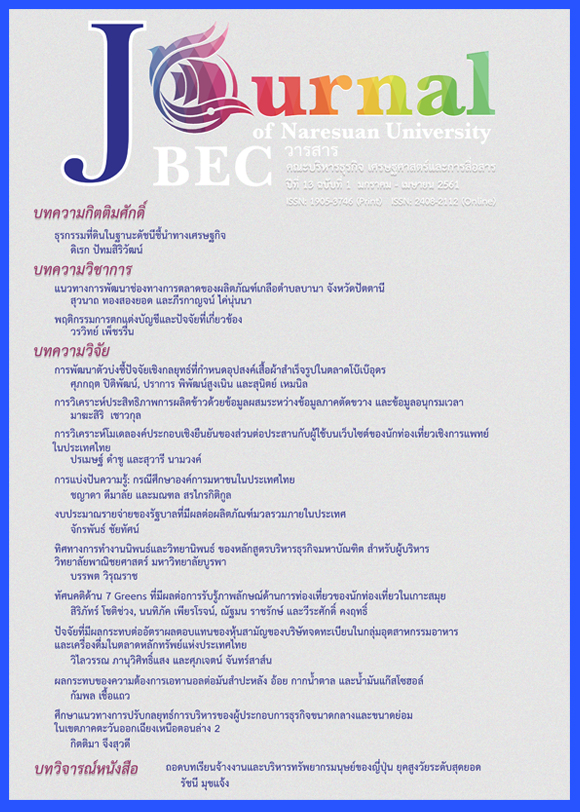การวิเคราะห์ประสิทธิภาพการผลิตข้าวด้วยข้อมูลผสมระหว่างข้อมูลภาคตัดขวาง และข้อมูลอนุกรมเวลา [An Analysis of Rice Production Efficiency Using Pooled Data]
Main Article Content
บทคัดย่อ
เขื่อนแควน้อยบำรุงแดน เริ่มก่อสร้างในปี 2546 วัตถุประสงค์หลักคือ เพื่อส่งน้ำให้กับการเพาะปลูกทั้งฤดูฝนและฤดูแล้ง รวมพื้นที่ชลประทานแควน้อยเท่ากับ 155,166 ไร่ การติดตามและประเมินผลสภาพเศรษฐกิจและสังคมของครัวเรือนในพื้นที่ของเขื่อนแควน้อยบำรุงแดนได้เริ่มตั้งแต่ปีงบประมาณ 2548 จนถึง2559 เพื่อใช้เป็นข้อมูลสำหรับการแก้ไขผลกระทบสิ่งแวดล้อมต่อครัวเรือนที่อาจจะเกิดขึ้นได้ในระหว่างการดำเนินการก่อสร้าง ข้อมูล Pooled Data ของการทำนาในปีเพาะปลูก 2548/2549 และ 2557/2558 ของครัวเรือนตัวอย่าง พื้นที่รับประโยชน์ของเขื่อนได้ถูกนำมาใช้ในการประมาณการฟังก์ชั่นการผลิตข้าว ทั้งข้าวนาปีและข้าวนาปรัง พร้อมวิเคราะห์ประสิทธิภาพของการใช้ปัจจัยการผลิตผันแปรแต่ละตัวและทำการประเมินการเปลี่ยนแปลงของประสิทธิภาพของการใช้ปัจจัยการผลิตนั้น เปรียบเทียบของ 2 ช่วงเวลา โดยใช้ตัวแปรปริมาณปุ๋ยเคมีสูตร 46-0-0 และสูตร 16-20-0 เป็นตัววัดประสิทธิภาพของการใช้ปัจจัยการผลิต พบว่า สำหรับข้าวนาปีค่าความยืดหยุ่นของผลผลิตข้าวต่อไร่ ทั้งข้าวนาปีและข้าวนาปรัง ต่อปัจจัยการผลิตผันแปรทุกตัวเป็นแบบยืดหยุ่นน้อย และประสิทธิภาพของการใช้ปัจจัยการผลิต วัดจากการใช้ปุ๋ยสูตร 46-0-0 และสูตร 16-20-0 ในการปลูกข้านาปีและข้าวนาปรังในปี 2557 ลดลงจากของปี 2548 ดังนั้น การเตรียมเกษตรกรในเรื่องการใช้ปัจจัยการผลิตให้เหมาะสม เพื่อให้การใช้ประโยชน์จากน้ำจากเขื่อนแควน้อยบำรุงแดนจะได้ เป็นไปอย่างมีประสิทธิภาพเพิ่มขึ้น
Article Details
เอกสารอ้างอิง
2. Ajibefun, I. A., Battese, G. E. and Kada, R. (2002). Technical efficiency technological change and productivity of hired and family labour in the Japanese rice industry. Empirical Economic Letters, 1(1), 21-31.
3. Battese, G. E. and Coelli, T. J. (1988). Prediction of firm-level technical efficiencies with a generalized frontier production function and panel data. Journal of Econometrics, 38(3), 387-399.
4. Battese, G. E. and Coelli, T. J. (1995). A model for technical inefficiency effects in a stochastic frontier production function for panel data. Empirical Economics, 20(2), 325-332.
5. Chaowagul, M. and Phahuyuth, D. (2007). An analyses of rice production efficiency in the beneficiary areas of the Kwae Noy Dam, year 2005/2006. Phitsanulok: Naresuan University.
6. Chaowagul, M. and Phahuyuth, D. (2004). Report on the socio-economic situation monitoring and evaluation, Kwae Noy Dam under His Majesty the King’s initiation, 2004. Phitsanulok: Naresuan University.
7. Chaowagul, M., Phahuyuth, D. and Pooncharoen, N. (2015). Report on the socio-economic situation monitoring and evaluation, Kwae Noy Dam under His Majesty the King’s initiation, budget year 2015. Phitsanulok: Naresuan University.
8. Chiang, A. C. and Wainwright, K. (2005). Fundamental methods of mathematical economics (4th ed.). USA: McGraw hill Education.
9. Gujarati, D. N. (2006). Essentials of econometrics. USA: McGraw hill Education.
10. Kyi, T. and Oppen, M. (1999). Stochastic frontier production function and technical efficiency estimation: A case study on irrigated rice in Myanmar. Retrieved July, 10, 2017, from http://ftp.gwdg.de/pub/tropentag/proceedings/1999/referate/STD_C6.pdf
11. Mochrie, R. (2016). Intermediate microeconomics. London: Palgrave and Macmillan.
12. Royal Irrigation Department. (2009). Examining project of the Kwae Noy Dam project under His Majesty the King’s initiation, Phitsanulok province. Retrieved July 10, 2017, from http://www.rid.go.th/royalproject/index.php?option=com_content&view=article&id=340%3A2009-06-15-04-41-33&catid=19%3A2009-05-04-06-40-57&Itemid=4
13. Sokvibol, K., Hua, L. and Linvolak, P. (2016). Technical efficiency and its determinants of rice production in Cambodia. Economies, 4(22), 1-17.


